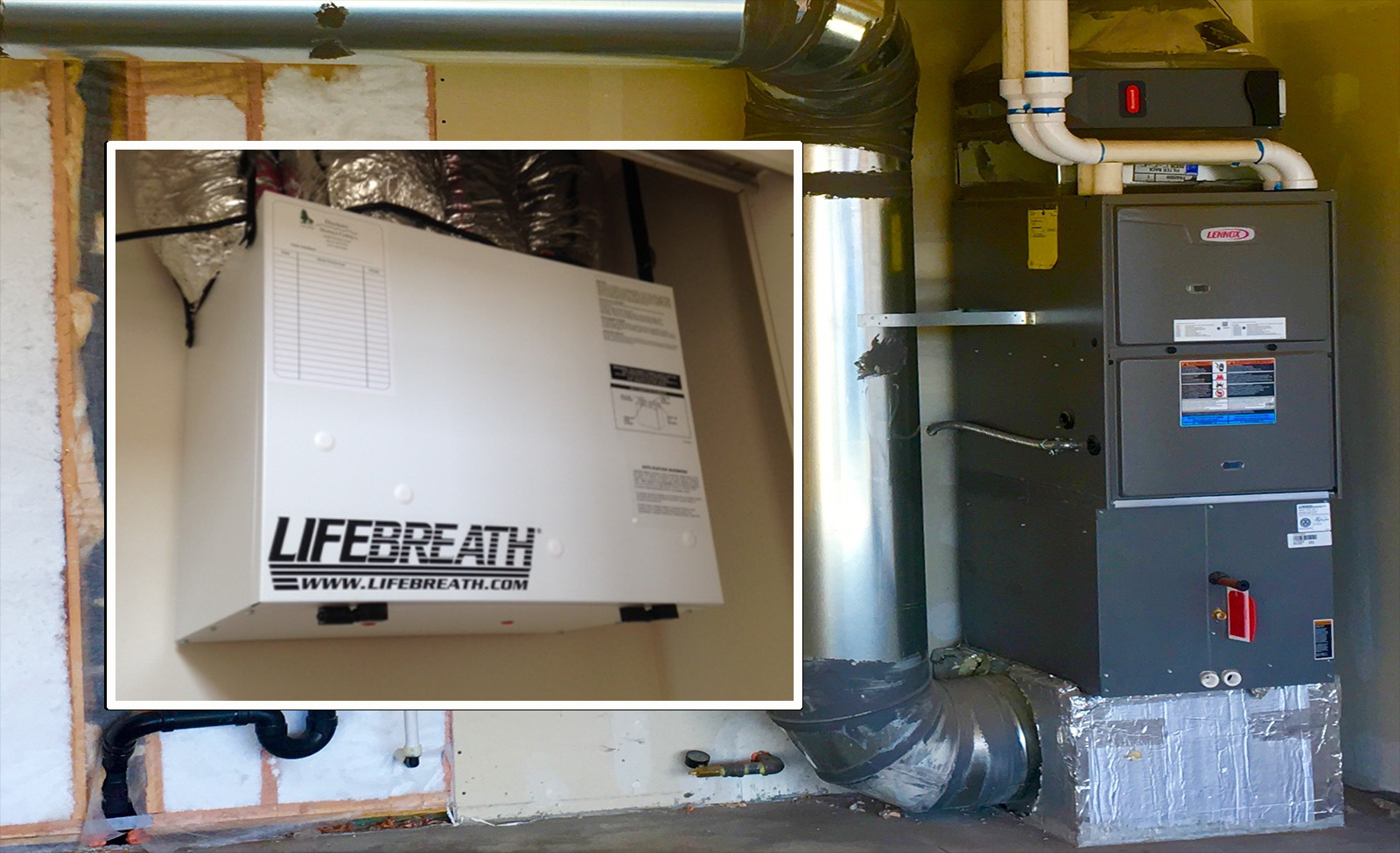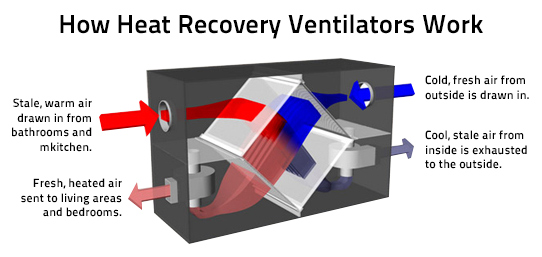How HRV Regulates Indoor Climate
Wiki Article
Revealing the Key Conveniences and Uses of Heat Recovery Ventilation in Lasting Style
Heat Recovery Ventilation (HRV) systems play a vital role in lasting style. They facilitate a continual exchange of stale interior air with fresh outside air, substantially improving indoor air top quality. HRVs contribute to energy performance by recovering warmth from tired air, which can lower utility costs. Recognizing the complex advantages and applications of HRVs exposes their relevance in modern design. What other benefits do these systems supply in the search of sustainability?Recognizing Heat Recovery Ventilation Equipments
Heat recovery ventilation (HRV) systems are made to improve indoor air top quality while lessening power loss. These systems use a mechanical ventilation approach to exchange stagnant indoor air with fresh outside air, ensuring a constant supply of clean air. By capturing warm from the exhaust air, HRVs prerequisite inbound air, reducing the demand on home heating and cooling down systems. This process not only boosts thermal comfort but additionally adds to energy effectiveness in residential and business structures. Furthermore, HRV systems help control moisture degrees and lower interior contaminants, promoting a much healthier living setting. Their tactical application is important for accomplishing lasting layout goals, as they use an equilibrium in between power conservation and occupant wellness.Exactly How HRV Equipment Job
While many might recognize with air flow systems, comprehending exactly how warm recuperation ventilation (HRV) systems operate is important for appreciating their benefits. HRV systems function by exchanging stale indoor air with fresh exterior air while moving warm between both streams. This process happens in a warmth exchanger, where warm from the outgoing air warms up the inbound air during colder months, lessening energy loss. On the other hand, in warmer months, the system can cool inbound air making use of the cooler outward bound air. HRVs are geared up with followers to facilitate airflow and filters to remove particulates, guaranteeing a continuous, well balanced air flow procedure. This ingenious layout not just improves energy performance but likewise adds to keeping a comfy indoor environment.Enhancing Indoor Air Top Quality
Interior air high quality can considerably affect wellness and wellness, making efficient ventilation crucial in modern homes. Heat Recovery Ventilation (HRV) systems play a vital role in keeping indoor air top quality by continuously trading stale indoor air with fresh outdoor air. This process not just reduces air-borne pollutants yet likewise decreases moisture levels, which can result in mold and mildew development and breathing problems. HRV systems filter inbound air, getting rid of irritants and particulates, therefore offering a much healthier living atmosphere. In addition, these systems help remove odors and unstable natural compounds (VOCs) generally found in family products. By making sure a consistent flow of tidy air, HRV systems contribute to a general better indoor environment, advertising comfort and wellness for owners.Energy Effectiveness and Price Financial Savings
Energy efficiency sticks out as a substantial benefit of Heat Recovery Ventilation (HRV) systems. By capturing and reusing the warm from tired indoor air, HRVs lessen the energy needed for home heating inbound fresh air, leading to lowered power consumption. This efficiency converts right into lower utility expenses, providing considerable expense savings for property owners and companies alike. Furthermore, HRV systems frequently receive energy efficiency motivations and rebates, better enhancing their monetary charm. In time, the first financial investment in HRV innovation can bring about a favorable return on financial investment via reduced power expenses. As a result, the assimilation of HRV systems not just advertises sustainable design however likewise offers a functional solution for attaining lasting energy cost savings and financial benefits.Ecological Benefits of HRV

A wide range of environmental advantages emerges from the execution of Heat Recovery Ventilation (HRV) systems. By successfully transferring warmth from exhaust air to inbound fresh air, HRVs considerably reduce the power needed for heating and cooling down spaces. This energy efficiency equates to decrease greenhouse gas discharges, adding to a reduction in the total carbon impact of structures. Additionally, HRV systems improve interior air quality by constantly distributing fresh air, thus decreasing the focus of indoor pollutants and irritants. Furthermore, the reduction in energy intake aids in saving natural resources, making HRVs a crucial part of sustainable style. On the whole, the ecological benefits of HRVs play an essential duty in promoting a healthier planet and cultivating environmentally friendly structure practices.
Versatile Applications in Modern Architecture
Heat recovery ventilation (HRV) systems are significantly being incorporated into both property and industrial building projects. In residential setups, HRVs boost interior air you could try these out quality while taking full advantage of energy performance. Meanwhile, in commercial rooms, these systems enhance ventilation strategies, showing their flexibility in modern-day building applications.Residential Projects Assimilation
While contemporary style significantly highlights sustainability, the integration of warmth recovery air flow systems in domestic projects has actually arised as a useful remedy for boosting indoor like this air quality and power performance. These systems successfully transfer warmth from exhaust air to incoming fresh air, minimizing power loss and decreasing heating or cooling needs. In brand-new builds and retrofits alike, warmth recuperation ventilation can be perfectly incorporated, giving home owners with a much healthier living setting while decreasing energy costs. Additionally, with increasing awareness of environmental impacts, more architects and contractors are recognizing the long-term advantages of these systems. Because of this, warm healing air flow has come to be an essential component of lasting domestic style, showcasing flexibility and commitment to environment-friendly methods.Commercial Rooms Optimization
As contemporary industrial spaces advance to satisfy the needs of sustainability and efficiency, the execution of warm healing ventilation systems becomes a vital technique for enhancing indoor settings. These systems help with the exchange of stagnant indoor air with fresh outdoor air while redeeming heat, substantially lowering power usage. This not just boosts convenience for passengers however likewise aids in decreasing functional prices. Flexible applications can be observed in workplaces, retail areas, and schools, where air top quality and temperature level control are vital. Additionally, integrating warm recovery air flow straightens with green building certifications, even more promoting environmental obligation. Inevitably, adopting such systems in industrial style not just adds to sustainability objectives however additionally fosters healthier, a lot more efficient rooms for individuals.
Incorporating HRV Into Sustainable Layout Practices
Incorporating warmth recovery air flow (HRV) systems into lasting style methods provides significant advantages in energy performance and interior air quality. By using HRV, developers can produce economical remedies that not just reduce energy usage but additionally boost the total comfort of interior environments. This alignment with sustainability objectives placements HRV as a necessary part in modern-day building strategies.
Energy Efficiency Enhancement
By incorporating warm recovery ventilation (HRV) systems into lasting style methods, architects and home builders can significantly improve energy go right here effectiveness in modern buildings. HRV systems operate by capturing warmth from outbound stagnant air and transferring it to inbound fresh air, minimizing the power required for home heating or cooling down indoor spaces. This procedure not just reduces dependence on typical HVAC systems however additionally reduces overall energy intake. In enhancement, HRV systems can aid keep a regular interior temperature, minimizing peak energy needs. By integrating these systems, structures can achieve significant reductions in energy costs and carbon footprints, straightening with sustainability objectives. Inevitably, HRV modern technology represents a functional option for enhancing energy performance in the built atmosphere, advertising more liable resource use.Indoor Air High Quality Renovation
How can warm recuperation air flow (HRV) systems add to premium indoor air top quality in modern-day structures? HRV systems successfully exchange stale indoor air with fresh outside air while recovering warm power, reducing temperature level variations. This process decreases the concentration of interior toxins, such as unpredictable natural compounds (VOCs), allergens, and wetness, which can degrade air top quality and effect passenger wellness. By keeping perfect moisture degrees and guaranteeing a constant supply of clean air, HRVs aid create a healthier indoor environment. Additionally, these systems can be integrated into sustainable design practices, promoting energy efficiency alongside enhanced air quality. HRV Heat Recovery Ventilation. Subsequently, HRV modern technology plays a vital duty in progressing total owner comfort and health in modern architectural stylesCost-efficient Style Solutions

Frequently Asked Inquiries
What Maintenance Is Needed for Heat Recovery Ventilation Systems?

Maintenance for warmth healing air flow systems commonly involves normal filter replacements, cleansing of warmth exchangers, evaluation of followers and ducts, and making certain proper drain. These tasks aid preserve performance and extend the system's lifespan gradually.
Can HRV Equipments Be Set Up in Existing Structures?
Heat recovery ventilation systems can certainly be set up in existing structures. HRV Heat Recovery Ventilation. Retrofitting requires mindful preparation and assessment of the building's format, ensuring compatibility with present systems while taking full advantage of power efficiency and indoor air top qualityHow Do HRV Solution Effect Sound Degrees Inside Your Home?
HRV systems can influence interior noise degrees by presenting sound from exterior sources through air flow. Top notch setups typically include sound-dampening attributes, decreasing noise effect while providing efficient air exchange and maintaining comfort inside your home.Exist Any Kind Of Disadvantages to Making Use Of HRV Equipments?
The drawbacks of utilizing HRV systems include potential high preliminary expenses, maintenance challenges, and the opportunity of minimized interior air quality if filters are not on a regular basis transformed, which might bring about concerns with moisture levels.How Do I Pick the Right HRV System for My Requirements?
Selecting the right warmth healing air flow system entails examining specific needs, such as constructing dimension, environment, and energy performance objectives. Additionally, assessing system functions, installation needs, and upkeep considerations is vital for peak performance and satisfaction.Report this wiki page